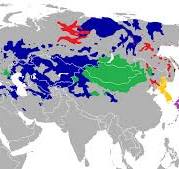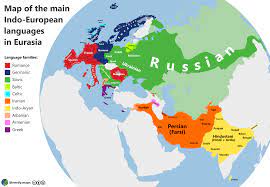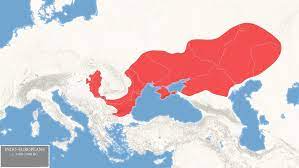PARENT, DAUGHTER, AND SISTER LANGUAGES
We are going to stick with language evolution and language history for quite a while, so better pause for a second and take a more rigorous, step-by-step approach.
If you remember what we have just seen you will immediately see why it makes sense to speak of “steps”. There will always be a “first” language at an earlier point in time, with some “following” languages lining up as time goes by.
In Linguistics, we call them “Parent Language” and “Daughter Languages”. All Daughter Languages from the same Parent Language are collectively called “Sister Languages”. Latin is the Parent Language of Spanish, French, Italian, Portuguese, which are its Daughter Languages, and which are Sister Languages to one another.
The thing is, this is not just an example, or a one-off thing that works for the Romance Languages. This is the one process that, with all its complexity and ramifications, has generated all the languages of the world.

Some cases are more bulky than others, but all languages have their own Parent Language – they all have their own equivalent of Latin. Same goes for Ancient/Middle Chinese, which is the Parent Language to many smaller groups of languages spoken in China, such as Mandarin, Yue/Cantonese, Wu, Gan, and so on.
As you can see, names can get confusing at times. The fact that there are fully separated words for “Latin” vs “Spanish” but not for “Ancient/Middle Chinese” vs “Mandarin Chinese” can be tricky. Let’s not be fooled here: despite the thing with naming, they have the same kind of Parent Language – Daughter Languages relationship.
LANGUAGE FAMILIES
It’s now time to take the final leap and look at the big picture – in fact, the biggest picture we can confidently speak about in the history of languages.
“Language Families” are the core of the classification system for languages. A Language Family is a group consisting of tens or even hundreds of different languages all connected to one another. As we have just learned, if they are connected to one another it means that, at least in a very remote past, they had some kind of common history and evolution.

Clearly, when the number of different members is so high, the internal structure of the Linguistic Family is complex and not all languages are connected to all others in the same way.
We can look at a Linguistic Family and recognize a recursive process of the same type as we have just discussed, with a Parent Language giving way to Daughter Languages, which in turn become Parent Languages to subsequent Daughter Languages, and so on. Therefore, there will be Sub-Families and all other sorts of subdivisions according to geography, culture, antiquity and so on.
Before we dive into the real-world descriptions, we will have to touch upon one last definition, that of Proto-Language.
The only way we can know exactly how a past-time language was like is when we have extensive written record of it. That’s the case with Latin, Ancient/Middle Chinese, Biblical Hebrew, Classical Arabic, and relatively few others.
Most of the time, though, there’s not a huge amount of text surviving from an ancient language, and in this case we speak of Proto-Language. When you see the name “Proto-[…]”, it’s because we know for sure that the language existed, but we don’t have enough resources to know with high precision how it sounded and looked like.
THE GERMANIC LANGUAGES
One very popular Proto-Language is the so-called “Proto-Germanic” Language. It could be a useful starting point for our discussion.
English, German and Dutch are classified together in the West Germanic group of Languages. Swedish, Norwegian and Danish are also part of a tightly-connected group, the North Germanic Languages.
By the names assigned to them you might easily guess that those two groups are, in turn, part of a common bundle. The subdivision in West Germanic and North Germanic tells us which languages are even closer to one another, but ultimately English, German, Dutch, Swedish, Norwegian, Danish, and others, are all Sister Languages.
Together, they make up the Germanic Languages.

But then, what exactly was their parent language? Turns out there was a language that we nowadays call Proto-Germanic from which all of those gradually emerged. Experts can only get a general idea of how this language worked, but we don’t have direct resources. No long texts written in Proto-Germanic have been found, and probably the people who spoke Proto-Germanic didn’t use writing that much at all.
Again, this is the reason for the definition “Proto-” language.
To bring up the habitual analogy, English, German, Swedish and so on had their own common ancestor, same as Spanish, French, and Italian. Differently from Latin, though, this common ancestor was not a language that people used in writing as commonly as Latin. We nowadays call this language “Proto-Germanic” to signal that we know something about the language – when it was spoken and where, plus educated guess about its words and rules – but we can not be 100% sure about any of it.
ONTO MACRO-FAMILIES
So Latin is the Parent Language to the modern Romance Languages and Proto-Germanic is the Parent Language to the modern Germanic Languages. What if I told you that they, in turn, have a common parent Language?
Even if you haven’t been part of the linguistic game for long, you might have heard the lallaby: all major languages of Europe are Indo-European except Basque, Finnish/Estonian, and Hungarian. Let’s see what this means exactly.
The Indo-European Family is so wide and diverse that it gained the title of Macro-Family. There is no clear cut definition of what a Macro-Family is, but the terms is used when a Language Family has an extraordinarily complex internal structure.

All languages belonging to the Indo-European Family (or Macro-Family) ultimately descend from a language that we call “Proto-Indo-European”. Once more, no written records, no texts, no way to be sure how it was spoken. But we know for sure that around the year 5000 BC there was a specific population that spoke a specific language which is the Parent Language to such diverse old languages as Latin, Proto-Germanic, Ancient Greek, Old Persian, Sanskrit and still a bunch of others.
It is useful speak of a Macro-Family because we can identify lower-level groupings which, in terms of their extension and complexity, would hold their ground against most of the world’s families. Think of the Slavic Languages, the Iranic Languages, the Indo-Aryan Languages, and so on, all belonging to the Indo-European Family.
Estimates about the timeline vary greatly, but its history goes more or less like this. Thanks to modern scientific discoveries we can be sure that there was a population, the “Indo-Europeans”, who shared a common language but also some common society and culture. In origin, they were probably settled north of the Black Sea, across a wide steppe-dominated region.

From this initial population, many different peoples then split in subsequent waves of migration. Those who settled in Italy gave birth to Latin, those who settled in Northern Germany gave birth to Proto-Germanic, and so on.
Eventually, the initial unity of the Indo-European population was lost and all different Subfamilies started to develop their own ways of doing culture, and, especially, language.
THE INDO-EUROPEAN LANGUAGE FAMILY
Here’s all the Language Families that belong to the Indo European Macro-Family. We also include some basic information about each and a few of their living members (i.e. languages still spoken nowadays), although the list has no intention of being exhaustive nor symmetrical.
- Italic Languages: all languages spoken nowadays that belong to this group are descendants of Latin, while the other Italic Languages (Oscan, Umbrian, Venetic, Faliscan…) were spoken by population that switched to speaking Latin after the Roman conquest of Italy. It includes Portuguese, Spanish, Catalan, Occitan, French, Francoprovençal, Ladin, Italian, Sardinian, Romanian.
- Germanic Languages: this groups is divided into three subgroups, West – English, Dutch, German, Frisian; North – Swedish, Danish, Norwegian, Icelandic, Faroese; and East – it includes no living languages, but a few old languages such as Gothic, Vandalic, Burgundian, spoken by some of the people that Romans collectively called “Barbarians”.
- Hellenic Languages: it only includes the living languages Tsakonian Greek (of controversial origin) and Modern Greek, the latter consisting of a few closely related varieties spoken across Greece and Cyprus.
- Slavic Languages: this family also has quite sharply defined subgroups, namely the Eastern Slavic branch – Russian, Ukranian, Belarussian; the Western Slavic branch – Polish, Czech, Slovakian; and the Southern Slavic branch – Bulgarian and the languages of former Jugoslavia.
- Baltic Languages: Latvian, Lithuanian, and the dead language Old Prussian (which had no speakers left by the year 1700).
- Celtic Languages: Irish and Welsh are those which still have a solid speakers community, then there are or were Scottish, Manx, Cornish, and Breton.
- Iranic Languages: the name refers to the languages spoken by the Iranian peoples, which have always played a key role in the history of Europe-Asia cultural contact and exchange. Some widespread living members are Persian, Kurdish, Pashto.
- Indo-Aryan Languages: these are spoken in the Northern half of India, in Bengala, on the Maldive Islands, and over portions of Nepal, Pakistan and Sri Lanka: Hindi, Urdu, Punjabi, Gujarati, Marathi, Bengali, Nepali, Sinhalese, Dhivehi, and many others.
- Albanian Language
- Armenian Language
- Anatolian Languages (no living daughter languages)
- Tocharian Language (no living daughter languages)

Leave a Reply